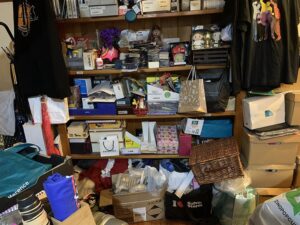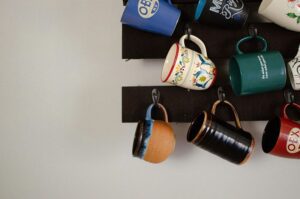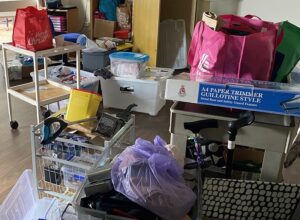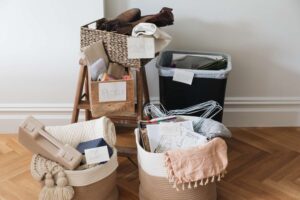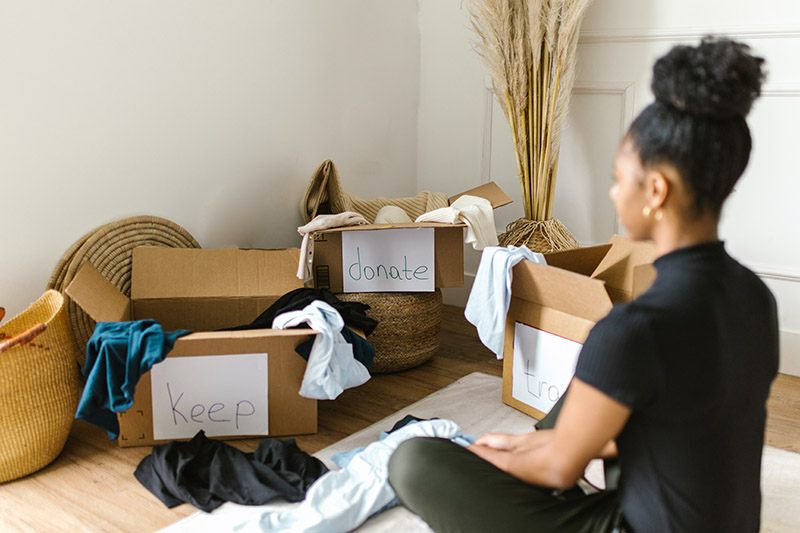
Common decluttering mistakes – how many are relatable?
1. Using the process as an excuse to shop for containers, decluttering books, label-makers and other false promises. Push back against the narrative that more stuff will make you happy. The goal is to remove, not add. Purchase containers only once you have finished decluttering, so you know what you need.
2. Trying to declutter multiple areas at once. If your whole house needs minimising, start with one space, one room, one cupboard, or one sock drawer. Stick to it – don’t drift off into another spot, or you may become overwhelmed.
3. Not having a vision for your space – a common decluttering mistake. Are you aiming for totally minimalist, or some everyday items on bench tops? Removing all books, or culling from three bookshelves to one? Know where you are heading before you start your journey. That way you can refer to your plan when you handle each item.
4. Not using a sorting system. Having tubs or piles for keep/donate/discard (etc) will keep you on track.
5. Focusing on other people’s stuff. Always start with your own.
6. ‘Tidying up’ without culling is another decluttering mistake and a misconception. Tidying means making neat piles of random stuff. Organising the piles (putting like with like) is better. But removing or minimising the piles altogether is better still. Keep weeding as you go.
7. Churning, or moving things to different places to ‘create space’ or avoid decisions. The best way to create space is to remove items from your home. Make a decision on everything you touch.
8. Throwing miscellaneous excess items into tubs and hiding them away. Those tubs are called doom boxes and will cause you or your loved ones great pain to disentangle in years to come. Trust me on this.
9. Not having criteria for what to keep. It doesn’t have to be “does it spark joy?” if you find this criterion impractical. How about “do I love this or need this?” or “do I have a realistic and foreseeable use for this?” You may need to change your criteria depending on the category (Food is treated differently to photographs, for example) so think about what works for you and tweak if necessary.
10. Thinking all your things are special. The endowment effect is one of a few weird biases about our stuff. Be curious. Zoom out and pretend you are a stranger to your belongings. A lot of it is unnecessary.
11. Being overly aspirational with things you intend to repair, sell, or use in an imagined, unlikely scenario. Just-in-case and aspiration clutter are big traps. Be realistic and choose your battles. Repairing piles of clothes when you don’t sew, or selling a whole bunch of items when you have zero time, are more fantasy than reality.
12. Keeping items just because you don’t want to create landfill. The landfill is already there. Do you want to live with it or not?
13. Keeping items because you don’t know where to donate them. If unsure, big op shops (Savers, Salvos, Vinnies) have high turnover and accept most things.
14. Keeping items because you spent money on them. Instead, think about what you’ve learned from that unnecessary purchase. E.g. purple is not your colour, or you will not use home exercise equipment. You can’t change your past mistakes, but you can learn from them. And that means improving your space by removing clutter.
15. Getting distracted in the micro, before you have done the macro. Now is not the time to sort your elastic bands by size and colour. First, try and get everything into their correct zones in the home, decluttering as you go. Micro-organising can wait.
16. Assuming you will remember your new zones and categories. To avoid this decluttering mistake, label everything. It makes maintenance so much easier, especially if you live with others.
17. Not maintaining. Keep away from shopping, and put things away in their assigned zones. If you have truly minimised, this will be super easy!
And the most important decluttering mistake of all…
18. Procrastinating. If you are reading this rather than decluttering, what are you waiting for?

